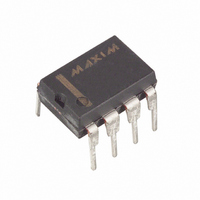MAX773CPD+ Maxim Integrated Products, MAX773CPD+ Datasheet - Page 17

MAX773CPD+
Manufacturer Part Number
MAX773CPD+
Description
IC CNTRLR DC-DC 14-DIP
Manufacturer
Maxim Integrated Products
Type
Step-Up (Boost)r
Datasheet
1.MAX770CSA.pdf
(20 pages)
Specifications of MAX773CPD+
Internal Switch(s)
No
Synchronous Rectifier
No
Number Of Outputs
1
Voltage - Output
5V, 12V, 15V, Adj
Current - Output
1A
Frequency - Switching
300kHz
Voltage - Input
3 ~ 16.5 V
Operating Temperature
0°C ~ 70°C
Mounting Type
Through Hole
Package / Case
14-DIP (0.300", 7.62mm)
Power - Output
727mW
Output Voltage
5 V to 12 V
Output Current
1 A
Input Voltage
2 V to 16.5 V
Supply Current
110 uA
Switching Frequency
300 KHz
Mounting Style
Through Hole
Maximum Operating Temperature
+ 70 C
Minimum Operating Temperature
0 C
Lead Free Status / RoHS Status
Lead free / RoHS Compliant
The two most significant losses contributing to the
N-FET’s power dissipation are I
losses. Select a transistor with low r
C
Determine the maximum required gate-drive current
from the Q
The MAX773’s maximum allowed switching frequency
during normal operation is 300kHz; but at start-up the
maximum frequency can be 500kHz, so the maximum
current required to charge the N-FET’s gate is
f(max) x Q
transistor data sheet. For example, the Si9410DY has a
Q
required to charge the gate is:
The bypass capacitor on V+ (C2) must instantaneously
furnish the gate charge without excessive droop (e.g.,
less than 200mV):
Continuing with the example, V+ = 17nC/0.1µF = 170mV.
Use I
resistor. See the Shunt Regulator Operation section.
Figure 2a’s application circuit uses an MTD3055EL
logic-level N-FET with a guaranteed threshold voltage
(V
8-pin Si9410DY surface-mount N-FET that has 50mΩ
on resistance with 4.5V V
less than 3V.
The MAX773 can drive NPN transistors, but be
extremely careful when determining the base-current
requirements. Too little base current can cause exces-
sive power dissipation in the transistor; too much base
current can cause the base to oversaturate, so the tran-
sistor remains on continually. Both conditions can dam-
age the transistor.
When using the MAX773 with an NPN transistor, con-
nect EXTL to the transistor’s base, and connect R
between EXTH and the base (Figure 8c).
To determine the required peak inductor current,
I
efficiency graphs and the theoretical output current
capability vs. input voltage graphs to determine a
sense resistor that will allow the desired output current.
Divide the 170mV worst-case (smallest) voltage across
the current-sense amplifier V
resistor value. To determine I
current (I
C(PEAK
RSS
g
TH
(typ) of 17nC (at V
) of 2V. Figure 2b’s application circuit uses an
to minimize these losses.
GATE
I
), observe the Typical Operating Characteristics
GATE
LIM)
g
g
(typ). Use the typical Q
when calculating the appropriate shunt
specification in the N-FET data sheet.
(max) = (500kHz) (17nC) = 8.5mA.
equal to the peak transistor collector cur-
5V/12V/15V or Adjustable, High-Efficiency,
______________________________________________________________________________________
GS
V+ = ——
GS
= 5V), therefore the current
, and a guaranteed V
Q
C2
B
g
CS
2
, set the peak inductor
R losses and switching
(max) by the sense-
g
Low I
NPN Transistors
number from the
DS(ON)
and low
Q
TH
BASE
, Step-Up DC-DC Controllers
of
rent I
Use the worst-case (lowest) value for ß given in the
transistor’s electrical specification, where the collector
current used for the test is approximately equal to I
It may be necessary to use even higher base currents
(e.g., I
operation by extending the transistor’s turn-off time.
R
Where V
mode V
transistor base-emitter voltage, V
drop across the current-sense resistor, and I
minimum base current that forces the transistor into
saturation. This equation reduces to (V+ - 700mV -
170mV) / I
For maximum efficiency, make R
sible, but small enough to ensure the transistor is
always driven near saturation. Highest efficiency is
obtained with a fast-switching NPN transistor
(f
voltage and a high current gain. A good transistor to
use is the Zetex ZTX694B.
The MAX770–MAX773’s high switching frequency
demands a high-speed rectifier. Schottky diodes such
as the 1N5817–1N5822 are recommended. Make sure
that the Schottky diode’s average current rating
exceeds the peak current limit set by R
its breakdown voltage exceeds V
ature applications, Schottky diodes may be inadequate
due to their high leakage currents; high-speed silicon
diodes may be used instead. At heavy loads and high
temperatures, the benefits of a Schottky diode’s low for-
ward voltage may outweigh the disadvantages of its
high leakage current.
The primary criterion for selecting the output filter
capacitor (C2) is low effective series resistance (ESR).
The product of the peak inductor current and the output
filter capacitor’s ESR determines the amplitude of the
ripple seen on the output voltage. An OS-CON 300µF,
6.3V output filter capacitor has approximately 50mΩ of
ESR and typically provides 180mV ripple when
stepping up from 3V to 5V at 1A (Figure 2a).
BASE
T
≥ 150MHz) with a low collector-emitter saturation
C(PEAK)
B
is determined by:
EXTH
= I
EXTH
R
B
BASE
.
LIM
. Calculate I
is the output voltage), V
is the voltage at V+ (in bootstrapped
/10), although excessive I
= ————————————–
(
V
EXTH
I
B
B
= I
as follows:
- V
LIM
Capacitor Selection
BE
/ß
Output Filter Capacitor
I
B
BASE
- V
CS
OUT
Diode Selection
CS
(min) is the voltage
. For high-temper-
(min )
as large as pos-
SENSE
BE
B
is the 0.7V
may impair
)
, and that
B
is the
LIM
17
.











